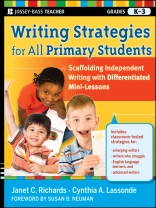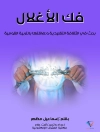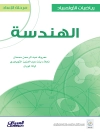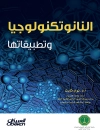A guide for teaching all your students the skills they need tobe successful writers
The 25 mini-lessons provided in this book are designed todevelop students’ self-regulated writing behaviors andenhance their self-perceived writing abilities. These foundationalwriting strategies are applicable and adaptable to all primarystudents: emergent, advanced, English Language Learners, andstruggling writers. Following the SCAMPER (Screen and assess, Confer, Assemble materials, Model, Practice, Execute, Reflect)mini-lesson model devised by the authors, the activities showteachers how to scaffold the writing strategies that students needin order to take control of their independent writing.
* Reveals helpful writing strategies, including makingassociations, planning, visualizing, accessing cues, usingmnemonics, and more
* Offers ideas for helping students revise, check, and monitortheir writing assignments
* Explains the author’s proven SCAMPER model that is appropriatefor students in grades K-3
Let Richards and Lassonde–two experts in the field ofchildhood education–guide you through these proven strategiesfor enhancing young children’s writing skills.
Innehållsförteckning
Foreword by Susan B. Neuman ix
Introduction 1
Section I Developing Understandings About Writing Strategy Mini-lessons
CHAPTER 1 Teaching Writing Strategies in the Classroom 9
Steve Graham
CHAPTER 2 Incorporating the SCAMPERWriting Strategy Mini-Lesson Model into Your Writing Program 21
Cindy Lassonde and Janet Richards
CHAPTER 3 Architecture of a Mini-Lesson 33
Anne Marie Juola-Rushton
CHAPTER 4 The Role of Teachers’ Evaluations 45
Jane Hansen
CHAPTER 5 Writing Strategy Instruction for Struggling Writers55
Rochelle Matthews-Somerville and Eva Garin
Section II Inventing Strategies
CHAPTER 6 Noun Charts 75
Cynthia B. Leung
CHAPTER 7 Growing a Poem with Interview Buddies 83
Cindy Lassonde
CHAPTER 8 Let’s Tell a Story 91
Janet Richards
CHAPTER 9 Writing Rockets and Other Graphic Organizers 99
Todd Sundeen
CHAPTER 10 Interest Charts 107
Susan Davis Lenski and Frances Ramos Verbruggen
Section III Drafting Strategies
CHAPTER 11 Reread So You Know What to Write Next 117
Deborah G. Litt
CHAPTER 12 Where Have I Seen That Word Before? 123
Ilene Christian
CHAPTER 13 Storyteller Blocks 131
Joyce C. Fine
CHAPTER 14 Adding Information 141
Jane Hansen
CHAPTER 15 To Rhyme or Not to Rhyme? 153
Cindy Lassonde
CHAPTER 16 Think, Draw, Write, and Share (TDWS) 161
Cynthia B. Leung
Section IV Polishing Strategies
CHAPTER 17 Act It Out to Discover the Details 173
Joanne Durham
CHAPTER 18 Personal Editing Checklists 181
Janet Richards
CHAPTER 19 Adding Dialogue to Fiction and Nonfiction 189
Lori Czop Assaf
CHAPTER 20 Following Conventions for Writing Dialogue 199
Deborah Guidry and Neva Ann Medcalf
CHAPTER 21 Color-Coding Editing 209
Janet Richards
CHAPTER 22 Turning Up the Volume of Voice in Poetry 215
Cindy Lassonde
CHAPTER 23 STEP into the Shoes of a Reader 223
Noreen S. Moore
Section V Comprehensive Strategies
CHAPTER 24 Making Pictures 237
Gail Verdi and Susan Polirstok
CHAPTER 25 Comprehensive, Step-by-Step Composing for Nonfiction Writing 249
Janet Richards
CHAPTER 26 Mentoring Authors’ Voices Through Readers’ Theater257
Timothy V. Rasinski and Chase J. Young
CHAPTER 27 Think Back, Look Forward 267
Tracy L. Coskie and M. Michelle Hornof
About the Authors 279
About the Contributors 281
Acknowledgments 287
Subject Index 289
Name Index 303
Om författaren
Janet C. Richards, Ph.D., is a professor at the Universityof South Florida in the Childhood Education and Literacy Studies Department, where she specializes in literacy. She is theeditor-in-chief of the Journal of Reading Education as wellas a literacy scholar for the International Reading Association(IRA).
Cynthia Lassonde, Ph.D., is associate professor, Elementary Education and Reading, at the State University of New York (SUNY) in Oneonta. Cynthia has co-authored several books, including Teacher Collaboration for Professional Learning.












